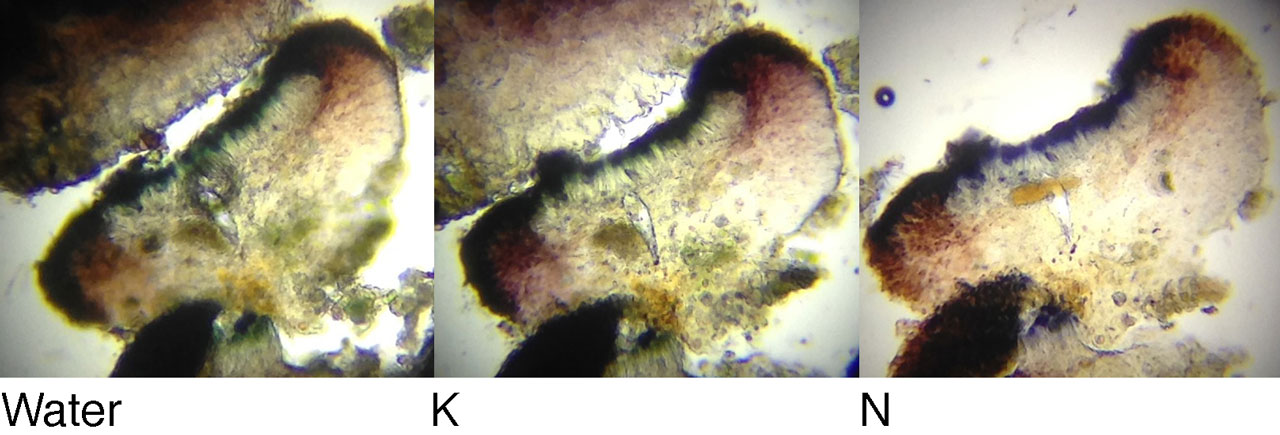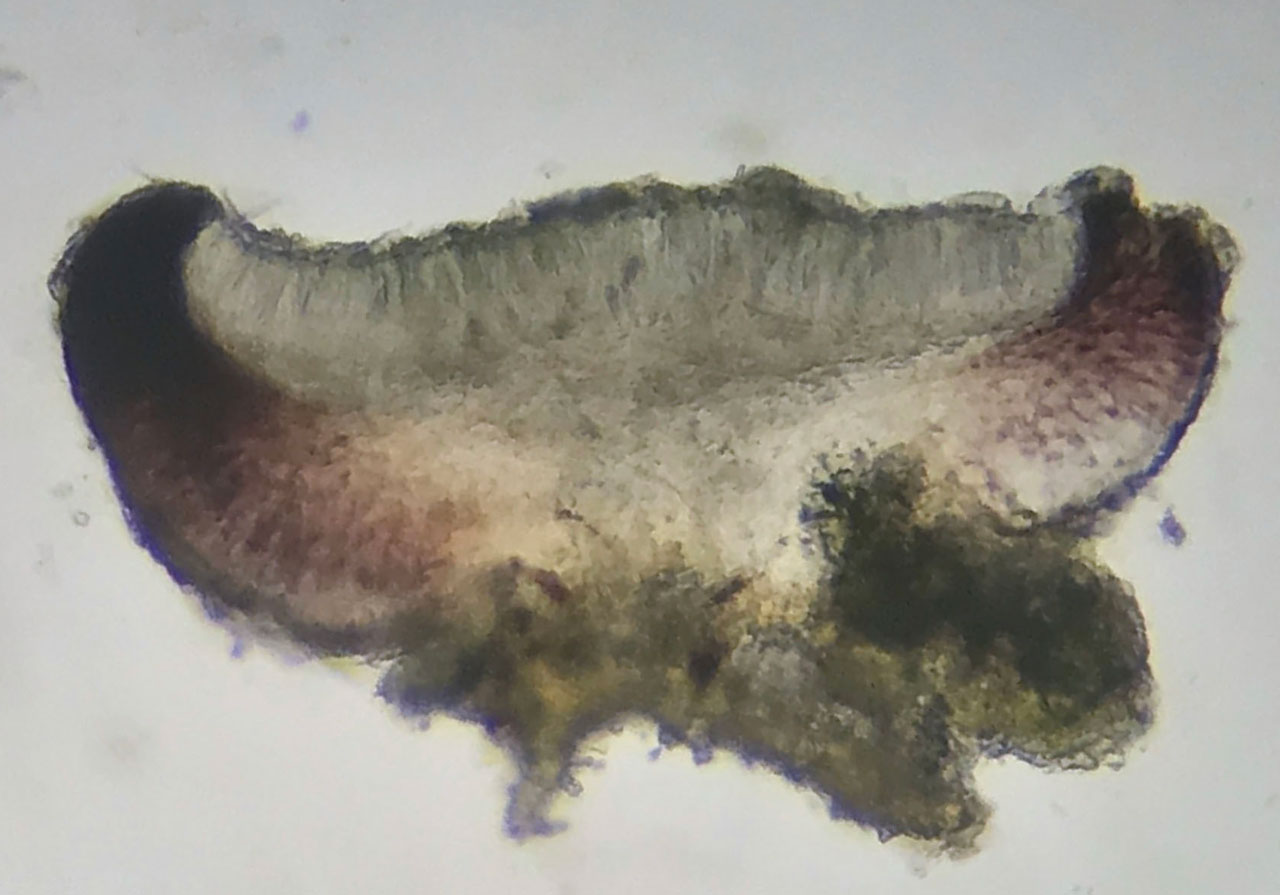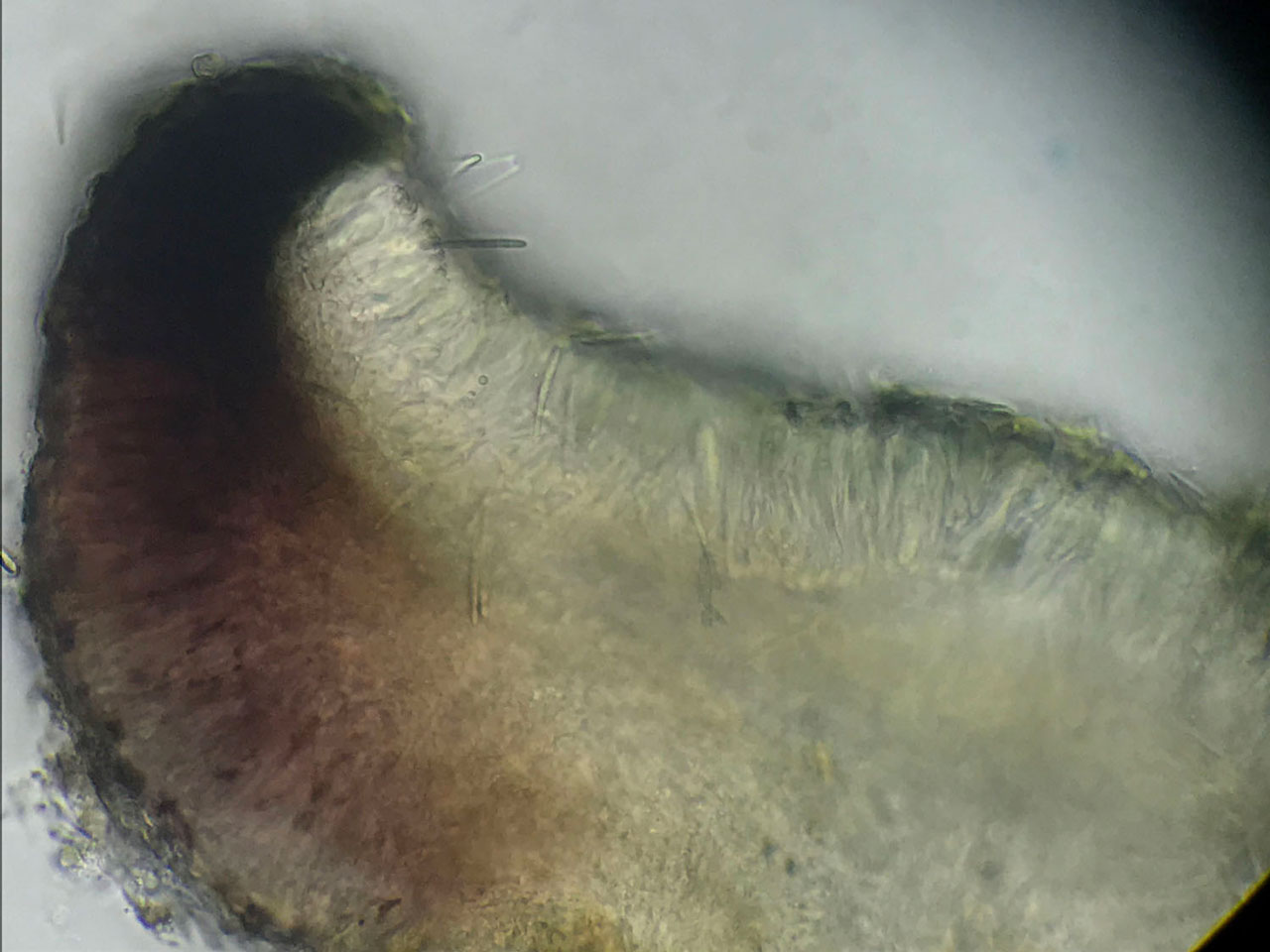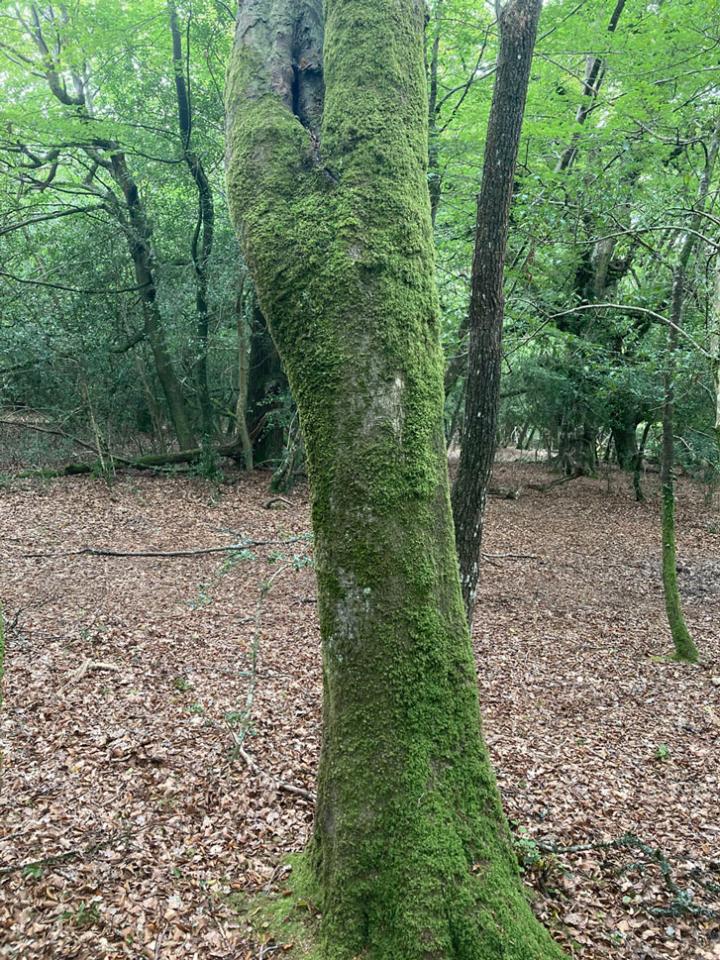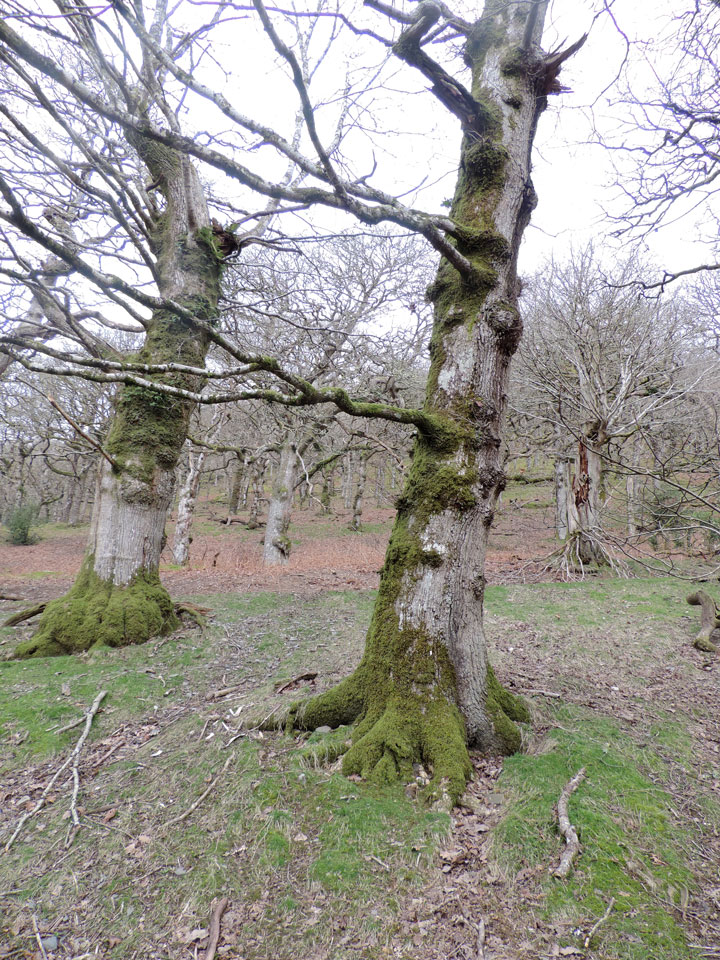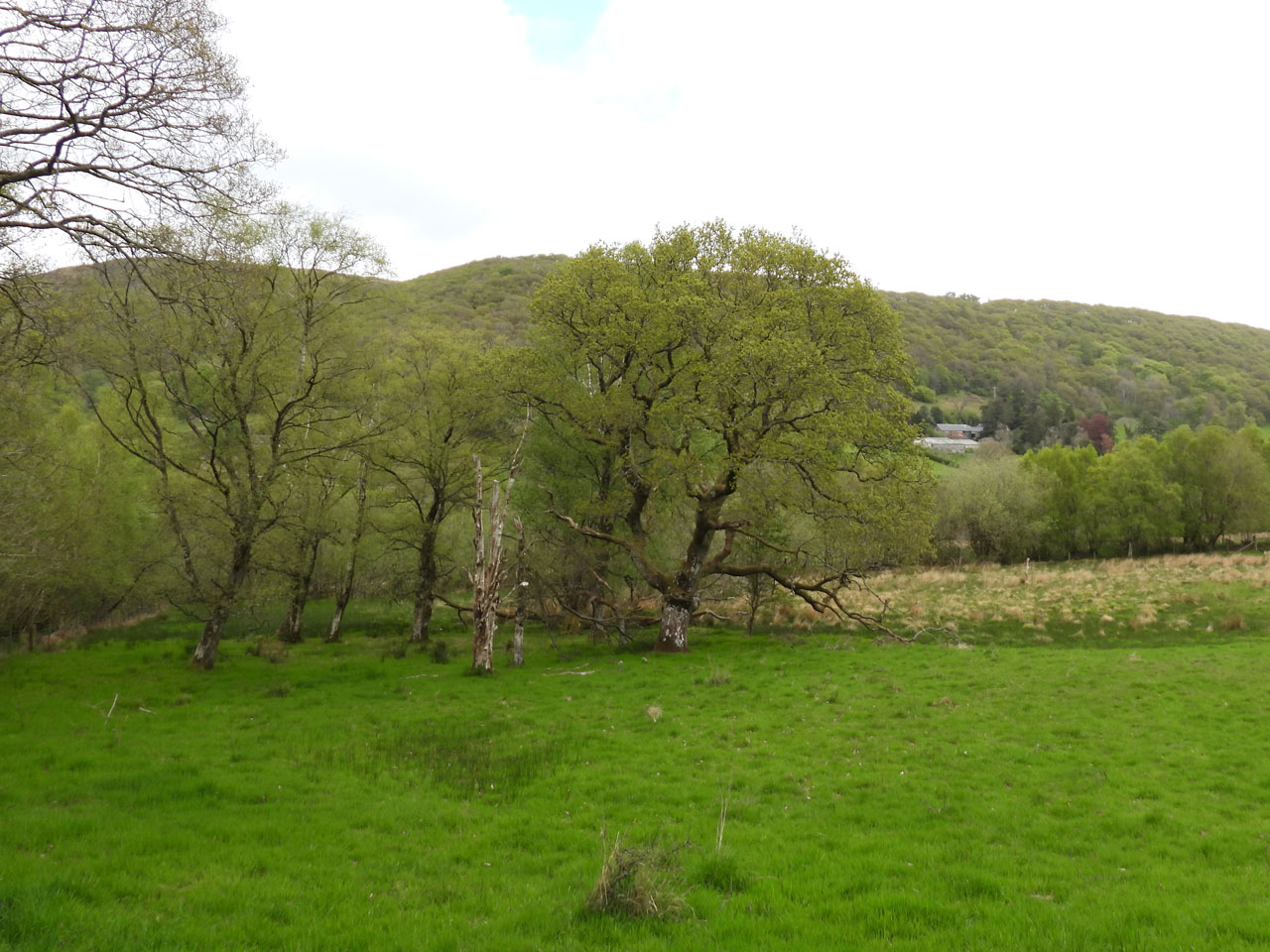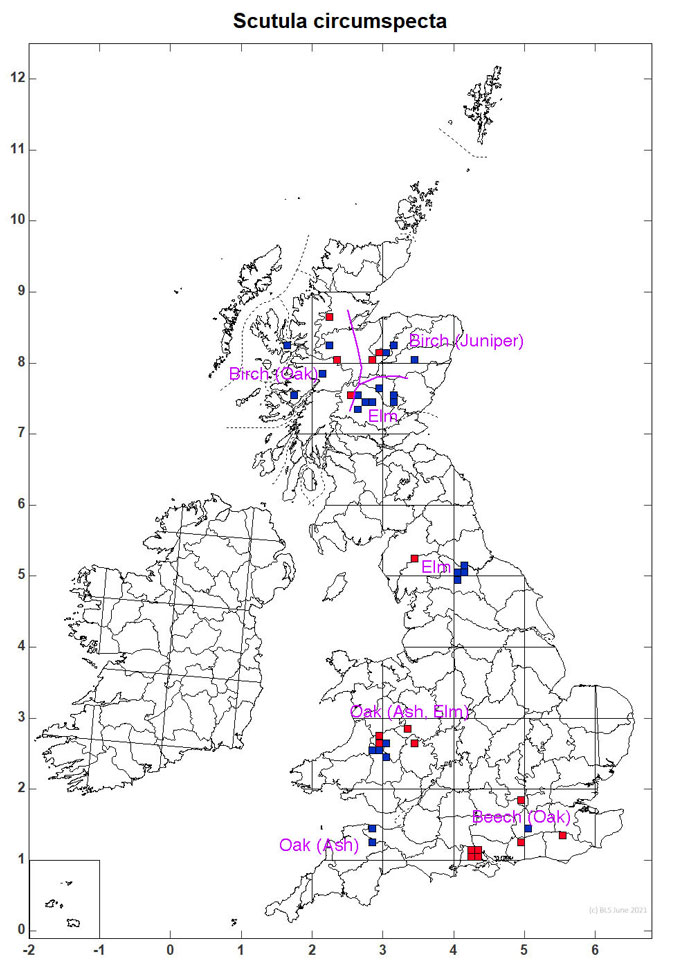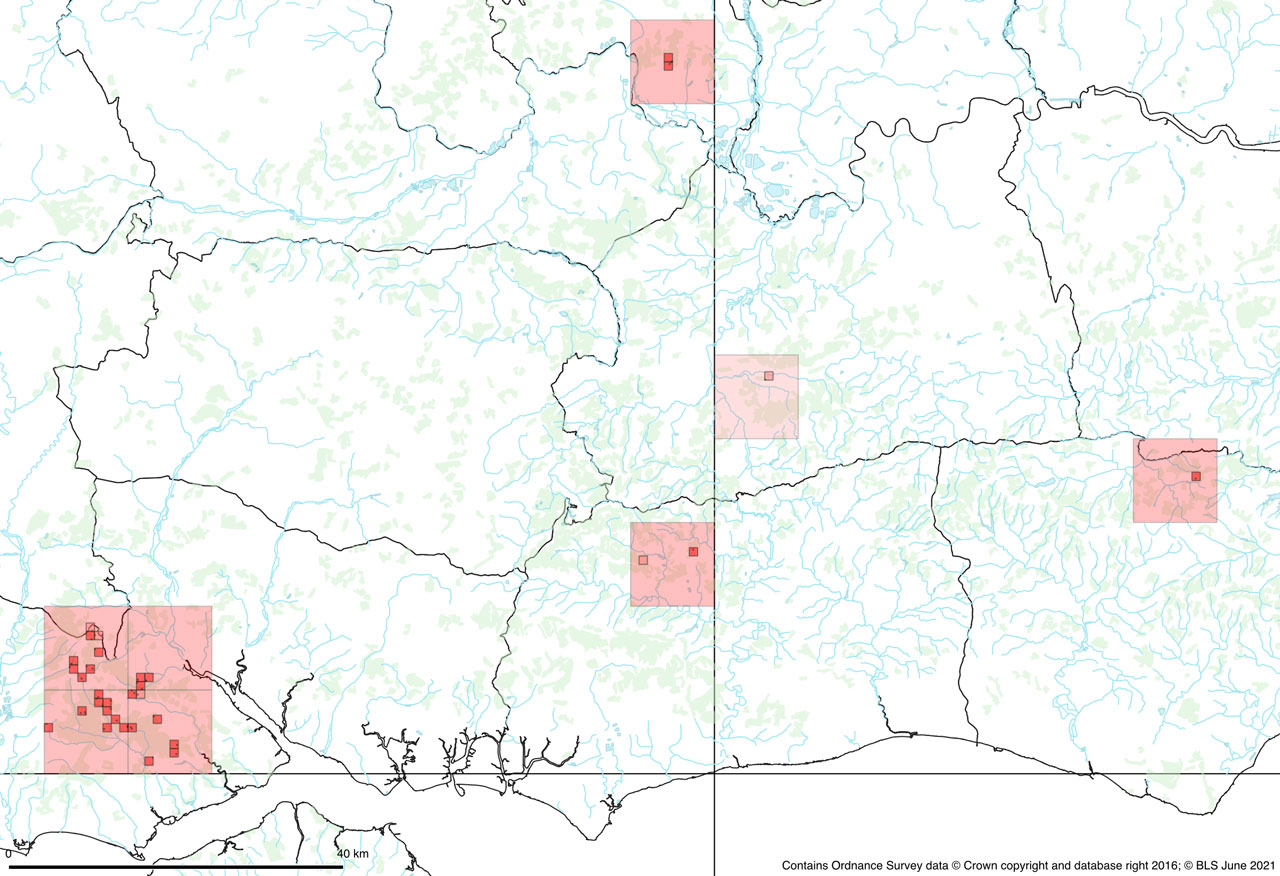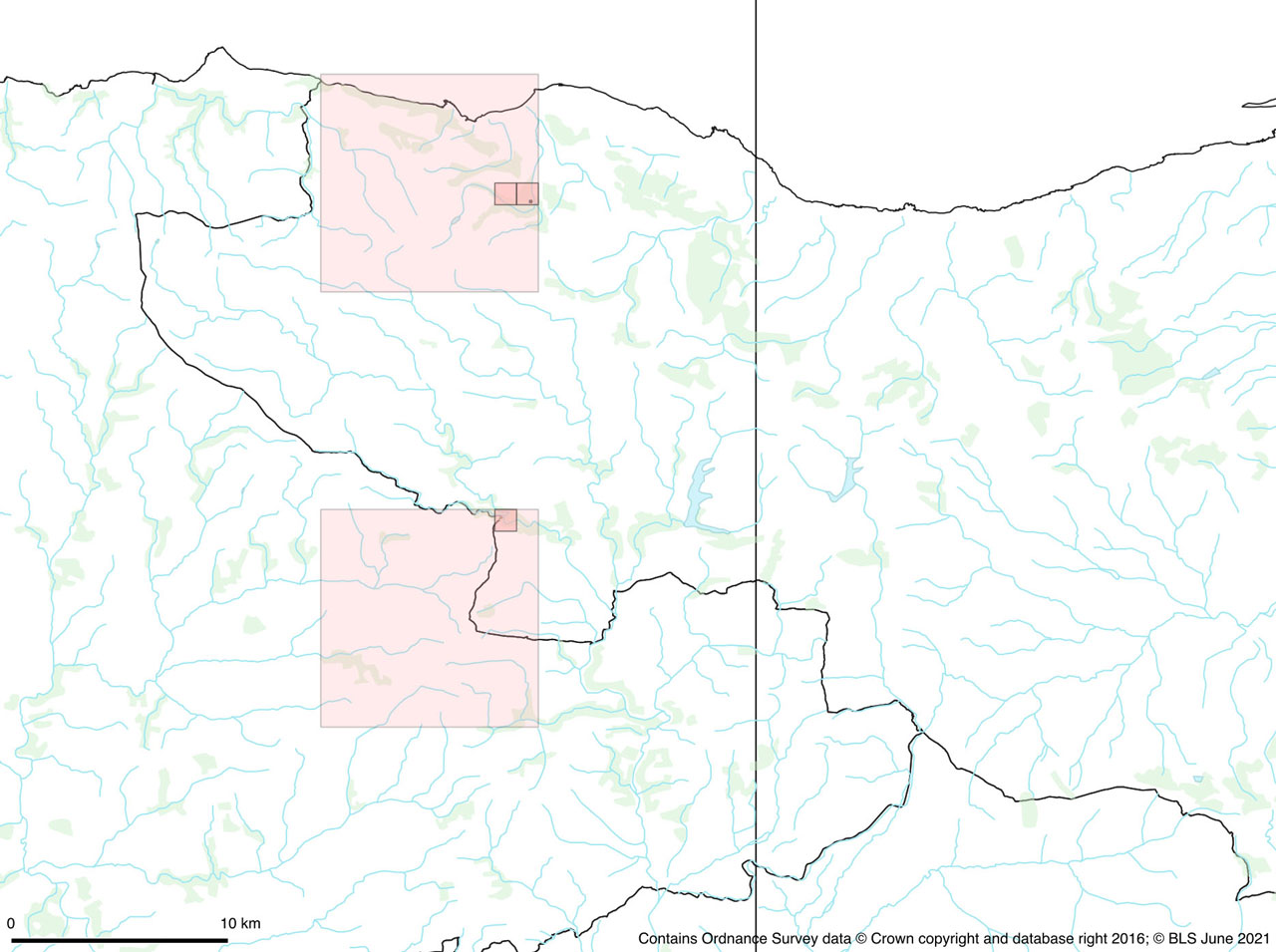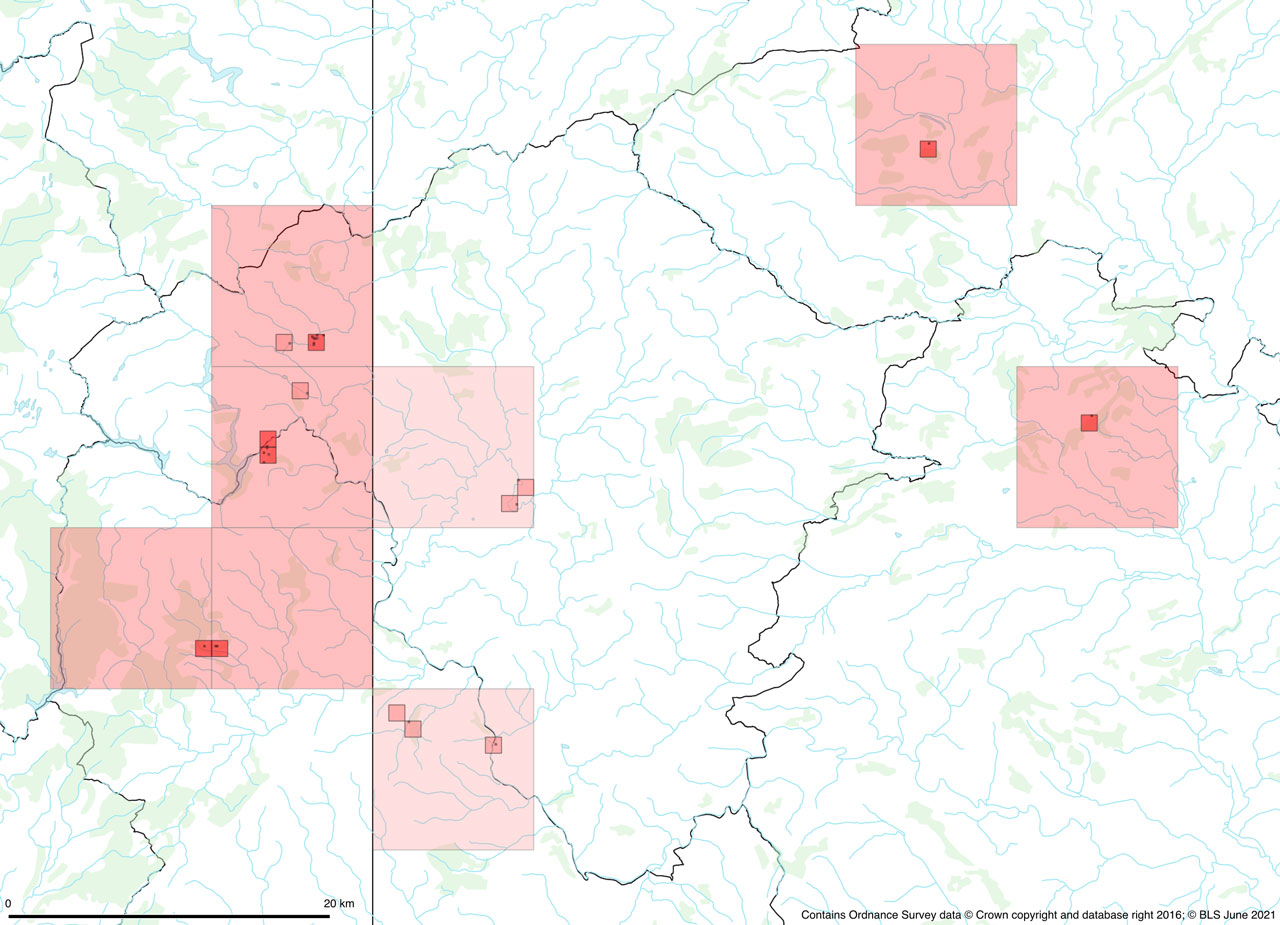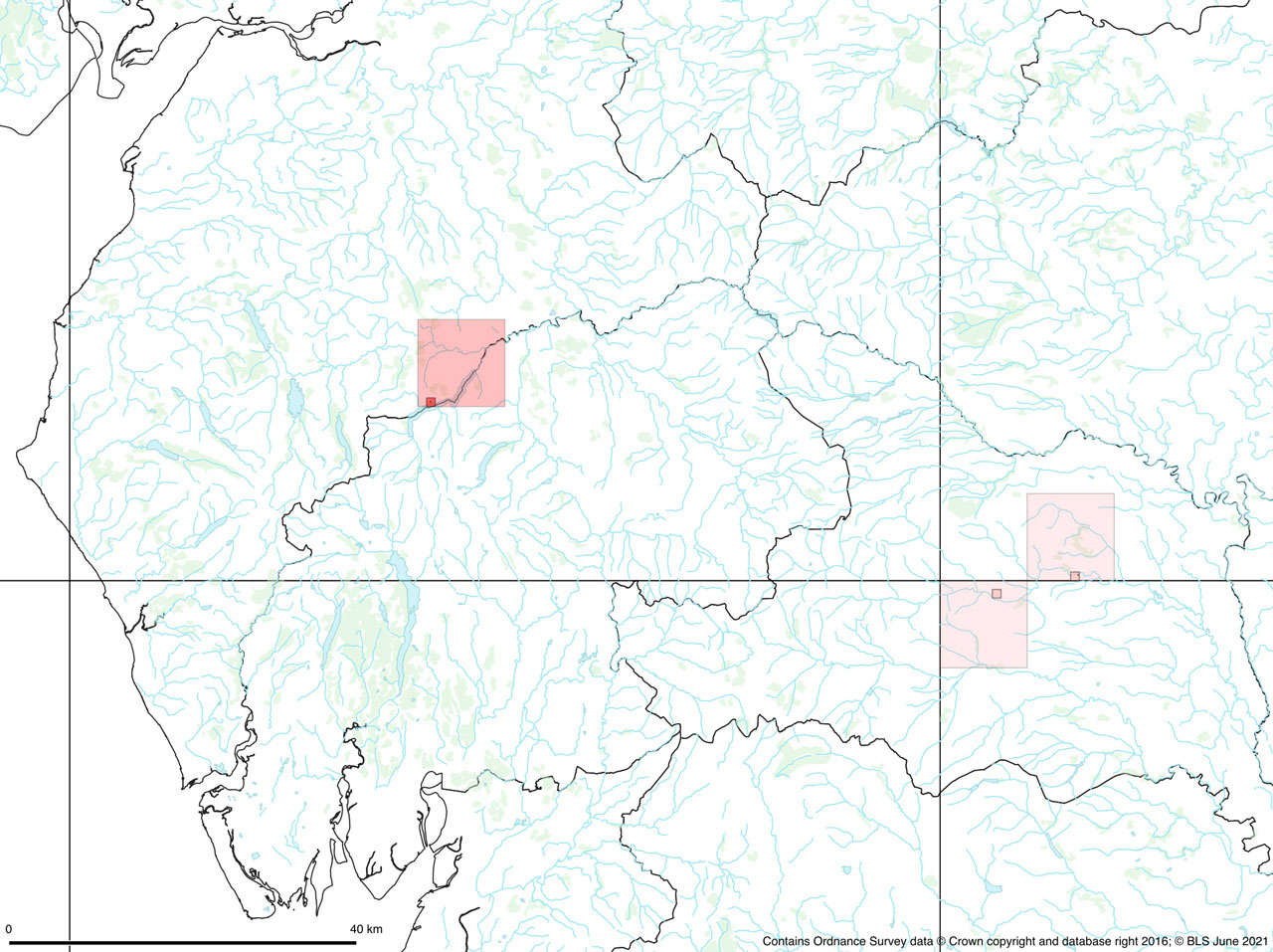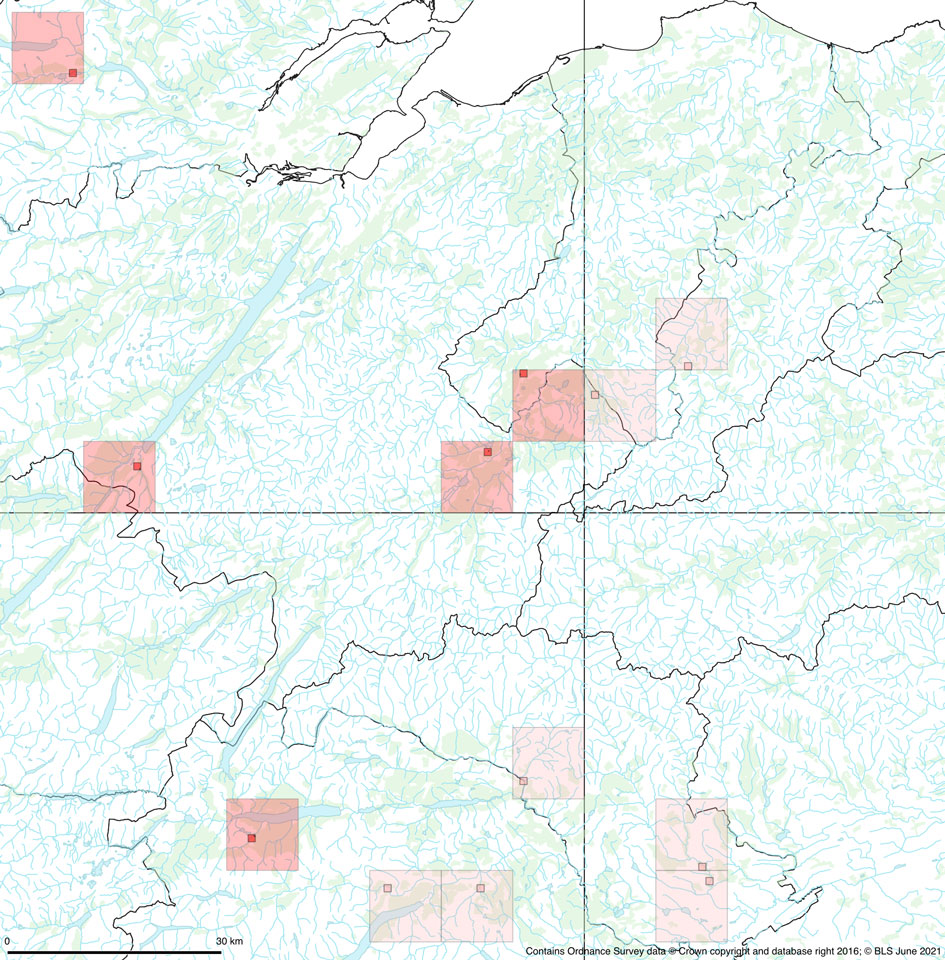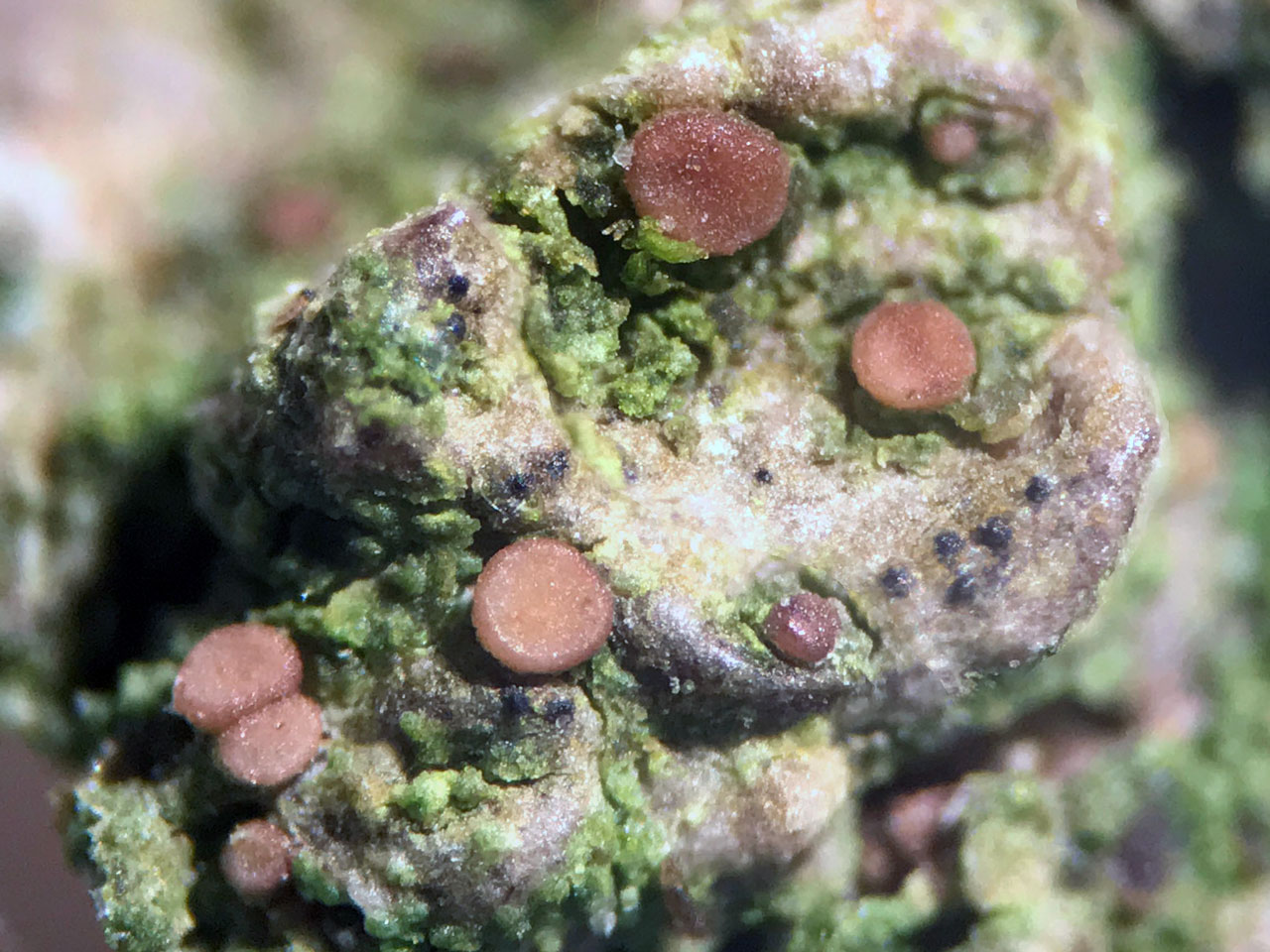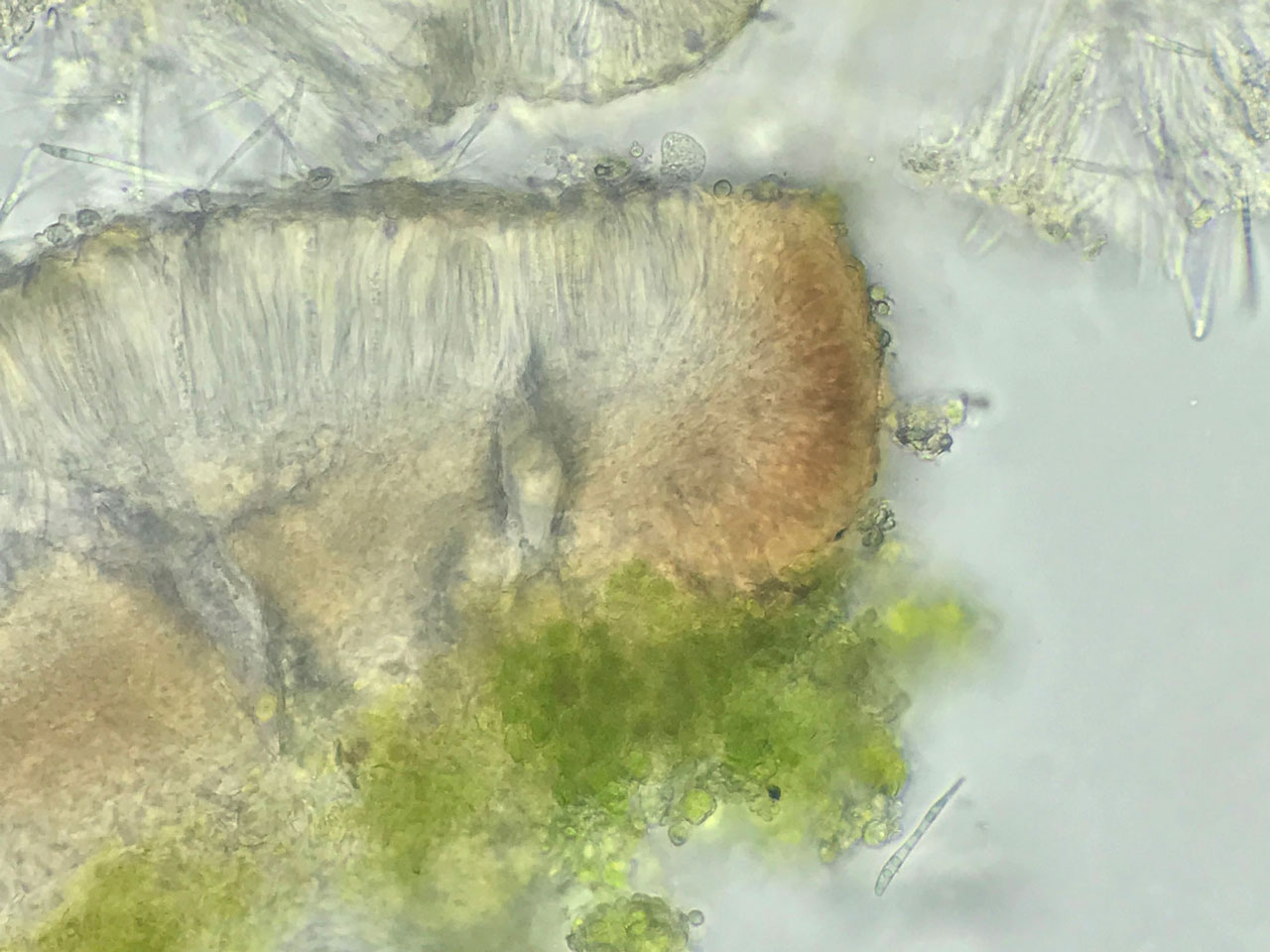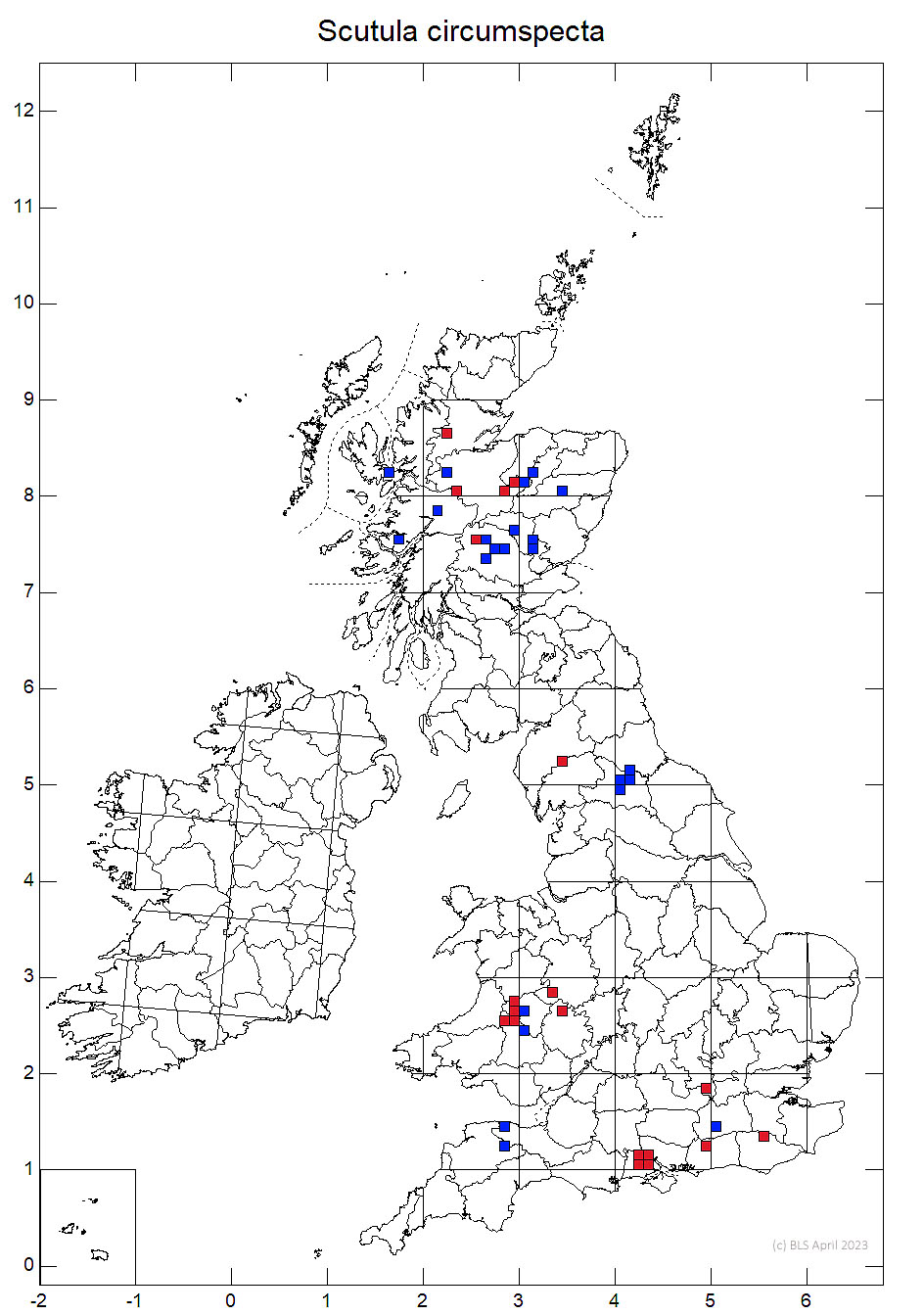Scutula circumspecta, can be spotted as small neat black disks with persistent margins on a thin white thallus with low green warts, growing in small gaps between bryophytes flushed base rich bark on veteran trees. A rare pigment deficient form with pale red-brown apothecia can be encountered and cause confusion. It is a rare species found sparingly in distinct regional clusters across Britain. It appears to be rather ephemeral and is found on small numbers of veteran trees at any one time and is likely to require large populations on veteran trees to maintain its survival. A species dossier was prepared (Sanderson, 2021) and is summarised here.
Thallus white or pale green-grey, thin, irregularly warted but without distinct granules; photobiont cells 7–14 (–16) μm diam. Apothecia 0.2–0.7 (–1) mm diam., flat, marginate, black; true exciple with upper part and outer edge dark purple-brown, K+ intensifying purple, becoming pale-coloured to colourless below; epithecium blue-green, K–, N+ purple-violet, often with blue crystals; hymenium 45–55 μm high, colourless or pale green above; hypothecium colourless or pale straw; paraphyses 1– 1.5 μm diam., unbranched or forked above, the apices often pigmented and swollen to ca 4 μm diam. Ascospores (18–) 20–30 (–38) × (1.5–) 2–2.5 μm, ± filiform. Pycnidia rare, 100–160 μm diam., sessile, ± globose, black, the wall with purple-brown and green pigments; conidia 7–9 × 1.5–2 μm, 0 (-1)-septate, cylindrical.
A rare pigment deficient form has been encountered in the New Forest where it was originally recorded as "Bacidia assulata auct. brit., non (Körb.) Vězda (1967)". This has pale red-brown apothecia and lacks both the dark purple-brown, K+ intensifying purple pigment in the upper exciple and the blue-green epithecium pigment. Otherwise it is identical with the typical form and the pale straw hypothecium pigment is still present and extends into the exciple.
Distinguished from Toniniopsis separabilis by the non-granular thallus and pale hypothecium, and from both Bibbya vermifera and B. subcircumspecta by the ascospores that are not tapered at the base and by the green epithecium. Bacidia igniarii has mostly shorter ascospores, and slightly smaller, barrel- to inversely cone-shaped apothecia. Bellicidia incompta, has a ditinctive dull green granular-verrucose thallus, lacks a green epithecium and has a dark red-brown hypothecium. With care, when the apothecia are damp, they can be cut in the field and the distinctive internal colour pattern with the dark purple-brown exciple grading into the pale straw to colourless hypothecium can be seen with a lens, reducing the need to collect specimens to confirm.
On trunks of Oak, Beech, Wych Elm, Ash, Birch and old Juniper, typically in small base-rich wound tracks, in old woodlands and less often field or parkland trees. Most trees or bushes supporting the species are also veteran trees. An exception are occurrences on small diameter suppressed and damaged Beeches in the New Forest, but all of these are inside old growth woodlands with frequent veteran trees. At one of the latter sites the tree occupied was known to have been planted in the 1950s. Scutula circumspecta is found in a wide variety of woodland types and tree species across Britain, from Sanderson (2021):
- Old growth Beech pasture woodlands in south central England, S. circumspecta on Beech and occasionally Oak.
- Old parkland, or unimproved farmland, with veteran trees, S. circumspecta on Oak, in south central England and Wales.
- Oak dominated pasture woodlands in the south west and Wales, S. circumspecta on Oak and rarely Ash and Elm.
- Ravine, dale and cliff woodlands in northern England and Perthshire, Scotland, S. circumspecta on Elm, with few recent records.
- In Birch and Pine pasture woodlands in native pinewood complexes in the eastern Highlands, with S. circumspecta on Birch and Juniper
- In Oak dominated pasture woodlands in the northern Highlands, with S. circumspecta on Oak and Birch.
The species is typically observed in small flushed areas of small scale would tracks where it is associated with mainly common pioneer lichens of damp base rich bark and latter succession bryophytes spreading in from intact vegetation. The associated species from 16 herbarium specimens are listed below (Sanderson, 2021):
| Species | Constancy |
| Scutula circumspecta | V |
| Metzgeria furcata | V |
| Zygodon rupestris | III |
| Porina byssophila | II |
| Normandina pulchella | II |
| Isothecium myosuroides | I |
| Strigula taylorii | I |
| Frullania fragilifolia | I |
| Lepraria finkii | I |
| Neckera complanata | I |
| Hypnum cupressiforme var. resupinatum | I |
| Bacidina phacodes | I |
| Caloplaca obscurella | I |
| Frullania dilatata | I |
| Anisomeridium polypori | I |

Rare. S. & N. England, Mid-Wales, E. Highlands of Scotland. The species is characterised by far separated regional clusters, themselves consisting of mixtures of isolated records and larger meta-sites. From Sanderson (2021) with updates to 2023:
- South Central England: a major meta-site in the New Forest, Hampshire with smaller populations at Ebernoe Common, West Sussex, Eridge Park, East Sussex and Burnham Beeches, Buckinghamshire with an old records at Albury Park, Surrey and Bexley Hill Common, West Sussex. Mainly recorded from Beech, with some records from Oak.
- Exmoor: a few records from Horner Combe and the Barle valley, on Oak and Ash, but not seen recently.
- Mid Wales & The Marches: a scatter of isolated records and three larger meta-sites that including recent records at Carngafallt, south of Elan Village, Gilfach and Allt-y-gest SSSI. The isolated records include recent records for Walcot Wood, Shropshire and Croft Ambrey, Herefordshire. Mainly on Oak, records from Elm and Ash.
- Swaledale: two old records from Elm in Swaledale, North Yorkshire, recorded in the 1960s. Not seen since.
- Lake District: a single recent record from the eastern Lakes on a surviving Elm tree.
- Scottish Highlands: includes three regional clusters, the Tay catchment, Speyside and Deeside and the Great Glen and the north. In the Tay catchment most records were old records from Elm in ravine woodlands, but there are a few newer records from Birch in native Pine pasture woodland. The Speyside and the north is different, at least for sites with detailed records with records from Birch and Juniper in Birch and Pine pasture woodlands in the former and Birch and Oak in Oak pasture woodlands in the latter. Both of the latter regional clusters have more recent records than the Tay catchment.
In most sites Scutula circumspecta has not been found on the same trees where it was recorded a decade or more before but is found on new trees. The old Oaks in the unimproved farmland at Gilfach, Wales, are an exception with stable populations surviving for several decades on field Oaks (Sanderson, 2022). The associated species and habitat suggest that it acts as an early colonist pioneer species in small areas of bare bark in small scale wound tracks or disturbed patches in base rich mossy bark on slow growing trees. The lichen must have an ability to rapidly colonise suitable areas of bare bark on base rich veteran trees. Overall populations in even large meta-sites are likely to be small at any one time. The New Forest has 44 records from 10m grid squares recorded between 2000 – 2024, while at Gilfach S. circumspecta was recorded from 6 Oaks by Sanderson (2022). All other sites have less than five trees recorded, often only one or two, and less than 100 trees have been recorded as supporting this species in the last few decades.
Threats / Factors Leading to Loss or Decline or Limiting Recovery:
- Unsuitable Long Term Management of Wider Habitat: given the apparent low density of occupation and, additionally its often short occupation of ephemeral habitats on suitable veteran trees, thriving S. circumspecta populations are likely to need large areas of well managed old growth woodland. This habitat needs to include numerous suitable well lit old or slow growing trees or bushes, in woods with frequent glades, in sheltered and humid locations. Declining grazing pressure, or even direct removal of grazing, is a significant threat in several traditionally grazed pasture woodland sites with S. circumspecta. In many southern pasture woodland sites that have been threatened by increasing shade, however, active conservation work is being widely carried out to counteract this.
- Loss of Locally Utilised Trees to Novel Tree Diseases: the impact of Dutch Elm Disease seems to have a serious impact on S. circumspecta in the north of England and in the Perthshire ravine woodlands. Ash Dieback is likely only to have a minor impact on S. circumspecta, but new diseases impacting Beech or Oak could seriously threaten the species.
- Impact of Air Pollution: acidifying pollution from sulphur dioxide is likely to have destroyed the habitat for S. circumspecta on less well buffered Oak bark in the north of England. Sulphur dioxide pollution has declined but nitrogen based pollution has not. Long distant dispersal of Nitrogen oxides (NOx) is still contributing to acid rain in high rainfall areas and still may be limiting the utilisation of less well buffered trees such as Oak in the Lake District. Ammonia, mainly sourced from agriculture is a more short distant pollutant but is potentially a threat where intensive agriculture, such as pig or chicken units, are spreading into previously relatively clean areas. This has been an on going issue within the Mid Wales & The Marches regional cluster for S. circumspecta (Bosanquet, 2019).
Britain: Vulnerable
Scotland: Priority Taxon for Biodiversity in Scotland
Wales: Vulnerable & Section 7 species
England: Section 41 species
Bosanquet S. D. S (2019) Lichen surveys to investigate ammonia impacts. NRW Evidence Report No: 298. Natural Resources Wales, Bangor.
Cannon, P., Aptroot, A., Coppins, B., Ertz, D., Sanderson, N., Simkin, J. & Wolseley, P. (2021). Arthoniales: Roccellaceae, including the genera Cresponea, Dendrographa, Dirina, Enterographa, Gyrographa, Lecanactis, Pseudoschismatomma, Psoronactis, Roccella, Schismatomma and Syncesia. Revisions of British and Irish Lichens 16: 1-22.
Sanderson, N. A. (2021) Scutula circumspecta Dossier. A report by Botanical Survey and Assessment for Natural England.
Sanderson, N. A. (2022) Epiphytic Lichen Survey of Gilfach, Radnor, 2022. A Natural Botanical Survey & Assessment report to Resources Wales & Natur Am Byth
Text by Neil A Sanderson based on Cannon et al (2019) & Sanderson (2021)


